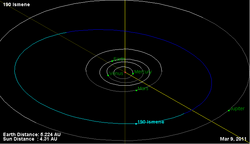Astronomy:190 Ismene
From HandWiki
 Orbital diagram | |
| Discovery | |
|---|---|
| Discovered by | C. H. F. Peters, 1878 |
| Discovery date | 22 September 1878 |
| Designations | |
| (190) Ismene | |
| Pronunciation | /ɪsˈmiːniː/[1] |
| Named after | Ismene |
| A878 SA; 1947 QJ; 1951 DB | |
| Minor planet category | Main belt (Hilda) |
| Orbital characteristics[2] | |
| Epoch 31 July 2016 (JD 2457600.5) | |
| Uncertainty parameter 0 | |
| Observation arc | 121.44 yr (44357 d) |
| |{{{apsis}}}|helion}} | 4.6480 astronomical unit|AU (695.33 Gm) |
| |{{{apsis}}}|helion}} | 3.3248 AU (497.38 Gm) |
| 3.9864 AU (596.36 Gm) | |
| Eccentricity | 0.16597 |
| Orbital period | 7.96 yr (2907.2 d) |
| Mean anomaly | 134.92° |
| Mean motion | 0° 7m 25.788s / day |
| Inclination | 6.1772° |
| Longitude of ascending node | 175.48° |
| 271.47° | |
| Physical characteristics | |
| Mean radius | 79.5 km [2] 90 km [3] |
| Rotation period | 6.52 h (0.272 d)3 |
| Geometric albedo | 0.066 |
| P | |
| Absolute magnitude (H) | 7.77[4] 7.59[2] |
Ismene (minor planet designation: 190 Ismene) is a very large main belt asteroid. It was discovered by German-American astronomer C. H. F. Peters on September 22, 1878, in Clinton, New York, and named after Ismene, the sister of Antigone in Greek mythology.
Being a P-type asteroid, it has a very dark surface. Ismene orbits near the outer edge of the asteroid belt. It is one of the largest members of the Hilda asteroid family, which are locked in 3:2 resonance with the planet Jupiter.[5]
References
- ↑ Noah Webster (1884) A Practical Dictionary of the English Language
- ↑ 2.0 2.1 2.2 Yeomans, Donald K., "190 Ismene", JPL Small-Body Database Browser (NASA Jet Propulsion Laboratory), https://ssd.jpl.nasa.gov/sbdb.cgi?sstr=190, retrieved 6 May 2016.
- ↑ "IOTA/IOTA-ES occultation update for (190) Ismene / TYC 0790-00635-1 event on 2014 Jan 18, 19:57 UT". Archived from the original on 2014-07-14. https://web.archive.org/web/20140714172851/http://www.asteroidoccultation.com/2014_01/0118_190_32108_Summary.txt. Retrieved 2014-06-11.
- ↑ Warner, Brian D. (December 2007), "Initial Results of a Dedicated H-G Project", The Minor Planet Bulletin 34: pp. 113–119, Bibcode: 2007MPBu...34..113W.
- ↑ Dahlgren, M.; Lagerkvist, C.-I. (October 1995), "A study of Hilda asteroids. I. CCD spectroscopy of Hilda asteroids", Astronomy and Astrophysics 302: 907, Bibcode: 1995A&A...302..907D.
External links
- 190 Ismene at AstDyS-2, Asteroids—Dynamic Site
- 190 Ismene at the JPL Small-Body Database
 |

